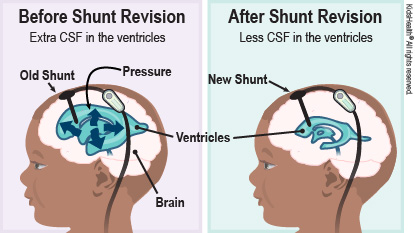Ventriculoperitoneal (VP) Shunt Revision: Caring for Your Child
A ventriculoperitoneal (VP) shunt treats hydrocephalus. VP shunts can get blocked or infected, or they can stop working. There was a problem with your child's old shunt, so it was replaced. This is called a VP shunt revision.


Follow your surgeon's instructions for:
-
when your child can eat and drink
-
giving pain medicines
-
continuing any medicines your child was on before the shunt was replaced
-
when your child can bathe
-
when your child can return to school, regular activities, and sports
-
when your child can use a hair dryer and hair products
-
any activities your child should avoid
-
taking your child to physical therapy (PT)
-
follow-up appointments

-
Your child has:
-
headaches that are different from usual or that don't go away with acetaminophen or ibuprofen
-
a fever of 100.4°F (38°C) or higher
-
nausea or vomiting
-
confusion or changes in behavior
-
trouble feeding or walking
-
unusual sleepiness or fussiness
-
a bulging soft spot (in babies)
-
redness, tenderness, or fluid leaking around where the surgery was done
-
redness or tenderness of the skin that covers the shunt tubing

Your child:

How do VP shunts work? Most VP shunts are thin plastic tubes connected with a valve. One end of the tube is in a ventricle of the brain. The other end passes out of the ventricle and goes under the skin down into the peritoneum. The valve opens when the pressure in the brain gets too high. This lets cerebrospinal fluid (CSF) drain from the brain into the peritoneum. From there, it's absorbed into the bloodstream and filtered out in the kidneys. Then the body can pee out the extra fluid.
Why do VP shunts need to be replaced? Problems with a VP shunt can happen even with regular care. The shunt may move because a child grows. The shunt may get worn out, or it may get infected. A shunt infection can be very serious. Be sure to follow your surgeon's instructions for when to call and when to go to the ER. This way, your child can start treatment as soon as possible.